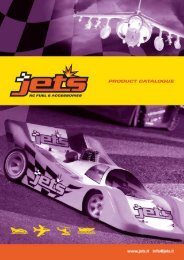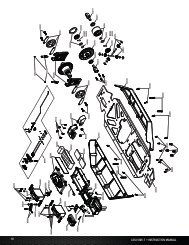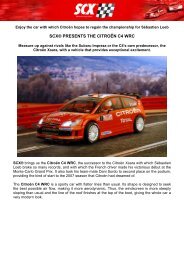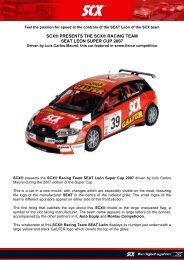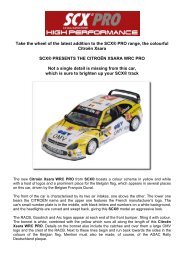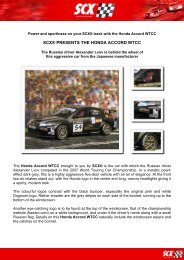Put the Williams team's quantum leap to the test
Put the Williams team's quantum leap to the test
Put the Williams team's quantum leap to the test
Create successful ePaper yourself
Turn your PDF publications into a flip-book with our unique Google optimized e-Paper software.
<strong>Put</strong> <strong>the</strong> <strong>Williams</strong> <strong>team's</strong> <strong>quantum</strong> <strong>leap</strong> <strong>to</strong> <strong>the</strong> <strong>test</strong><br />
on your SCX ® digital circuit<br />
SCX ® PRESENTS THE WILLIAMS TOYOTA FW29<br />
The gorgeous blue and white British car driven by Nico Rosberg<br />
is brought <strong>to</strong> you by SCX ® <strong>the</strong> digital system<br />
The <strong>Williams</strong> Toyota FW29 driven by Nico Rosberg in <strong>the</strong> 2007 Formula 1 World<br />
Championship is among <strong>the</strong> la<strong>test</strong> novelties brought <strong>to</strong> you by SCX ® <strong>the</strong> digital system. With<br />
a bodywork very similar <strong>to</strong> that on <strong>the</strong> 2006 model, apart from <strong>the</strong> white part being on <strong>the</strong> nose<br />
instead of <strong>the</strong> side, <strong>the</strong> car boasts a discreet but smart colour scheme, using no more than<br />
shades of blue and <strong>the</strong> white mentioned above.<br />
The first thing <strong>to</strong> catch <strong>the</strong> eye in this SCX ® <strong>the</strong> digital system model is <strong>the</strong> simplicity of <strong>the</strong><br />
front spoiler compared <strong>to</strong> <strong>the</strong> <strong>team's</strong> previous model. This is one of many changes implemented<br />
on this vehicle. Small fins can be seen projecting from <strong>the</strong> <strong>to</strong>p of <strong>the</strong> nose.<br />
Rosberg's cockpit features <strong>the</strong> driver with fully detailed suit and helmet, <strong>the</strong> latter in red and<br />
yellow, contrasting with <strong>the</strong> vehicle's colour scheme. Behind <strong>the</strong> figure of <strong>the</strong> German driver a<br />
headrest sticks up, with his name and an aerodynamic fin on each side.
As usual on Formula 1 cars, <strong>the</strong> nose area is where <strong>the</strong> main sponsors' logos appear. In this<br />
case <strong>the</strong> names of Philips, Airasia and Randstad accompany <strong>the</strong> driver's number 16. The only<br />
feature o<strong>the</strong>r than <strong>the</strong> advertising is <strong>the</strong> telecommunications aerial.<br />
The <strong>Williams</strong> Toyota FW29 from SCX ® <strong>the</strong> digital system also includes <strong>the</strong> logos on <strong>the</strong><br />
wheels and tyres. In fact, both sides are decorated with a wealth of logos, each of <strong>the</strong>m in<br />
proportion <strong>to</strong> <strong>the</strong> importance of <strong>the</strong> sponsor in question. Never<strong>the</strong>less, <strong>the</strong> most striking feature<br />
on <strong>the</strong> side of <strong>the</strong> car is without a doubt <strong>the</strong> air intake, with a small fin projecting from it.<br />
More small fins are fitted fur<strong>the</strong>r back, where <strong>the</strong> dominant feature is <strong>the</strong> large rear spoiler. The<br />
sides of <strong>the</strong> spoiler are decorated with <strong>the</strong> AT&T and Hamleys logos. The Lenovo logo appears<br />
on <strong>the</strong> <strong>to</strong>p of <strong>the</strong> spoiler. Like <strong>the</strong> o<strong>the</strong>r SCX ® Formula 1 cars, this model includes <strong>the</strong> centre<br />
brake light (though it does not work) and two exhaust pipes.
Track Trials<br />
SCX ® has been offering digital Formula 1 cars thanks <strong>to</strong> <strong>the</strong> small-size digital chip for two<br />
seasons now, so that you can run F1 races with all <strong>the</strong> au<strong>the</strong>nticity of <strong>the</strong> real thing. Pit s<strong>to</strong>ps,<br />
refuelling and overtaking tactics, all accurate <strong>to</strong> scale. All of it as real as what you see on TV on<br />
a Sunday.<br />
The chassis of <strong>to</strong>day’s SCX ® F1 models are not very different one from ano<strong>the</strong>r. They are<br />
competing on a level playing field. This is a series of scale model cars which are similar in<br />
design, shape and weight, with <strong>the</strong> same tyres and power and transmission system.<br />
These are models which impress by <strong>the</strong>ir excellent proportions. They have a narrower wheel<br />
track and are longer, which means a generous guide distance. The result is a more stylised car,<br />
a scale representation of modern F1’s. Its light weight gives it dynamism, less inertias and<br />
increased agility in changing lanes and <strong>to</strong> s<strong>to</strong>p in <strong>the</strong> boxes with a minimum of manoeuvring.<br />
These Formula 1 cars are longer and narrower than o<strong>the</strong>r SCX ® models and can race side by<br />
side without any risk of colliding. Overtaking a slower car is not hard. We conducted <strong>the</strong> trials<br />
with <strong>the</strong> extra magnet fitted, adjusted using <strong>the</strong> screws <strong>to</strong> be as close as possible <strong>to</strong> <strong>the</strong> track.<br />
Using a piece of material just over a millimetre thick will make <strong>the</strong> magnet very low and highly<br />
effective.<br />
On <strong>the</strong> track <strong>the</strong> F1’s are very fast, with plenty of acceleration thanks <strong>to</strong> <strong>the</strong>ir length and a<br />
healthy skid when <strong>the</strong> magnet loses contact. Their behaviour overall is very similar <strong>to</strong> <strong>the</strong> o<strong>the</strong>r<br />
digital system cars, and it is probably <strong>the</strong>ir single-seater appearance that gives <strong>the</strong>m that edge<br />
of intensity that <strong>the</strong>y exude.<br />
* Digital cars are <strong>test</strong>ed with fac<strong>to</strong>ry settings.<br />
Sport Table of Measurements<br />
Wheelbase 96mm Bearing Bronze double-wall<br />
Guide distance 103mm Crown Scalextric grey plastic<br />
Front wheel track 54mm Car weight 73g<br />
Front wheel diam. 19mm Body weight 10.5g<br />
19.5 x 11 3-line Digital chip Special F1<br />
Front tyre<br />
rubber. Front<br />
Rear wheel track<br />
semi-axles<br />
59mm Mo<strong>to</strong>r Rx44 Special Digital<br />
Wheel diameter 20mm Transm. type 4x2 direct rear<br />
Rear tyre<br />
20x12<br />
rubber<br />
3-line<br />
Transm. ratio 9/27 = 3<br />
Guide type Digital black<br />
Au<strong>to</strong>Return<br />
Suspension<br />
Braids Double<br />
Screws 4 (1+1+2)<br />
Ground Effect Yes, adjustable<br />
magnet<br />
O<strong>the</strong>rs Steering system<br />
Multi-part bodyshell<br />
Product reference no.: 13540
The Real <strong>Williams</strong> F1 2007<br />
The <strong>Williams</strong> <strong>team's</strong> la<strong>test</strong> car has a Toyota engine. The <strong>Williams</strong> Toyota FW29 was launched<br />
at <strong>the</strong> <strong>team's</strong> base in Oxford in late 2006.<br />
The car is in line with <strong>the</strong> philosophy of its predecessor, with a design which leaves no place for<br />
wasted energy. Ano<strong>the</strong>r notable feature of <strong>the</strong> new version is <strong>the</strong> improved cooling without<br />
using larger air intakes, improved mechanics and a structural redesign of <strong>the</strong> chassis <strong>to</strong><br />
minimise <strong>the</strong> problems it suffered in <strong>the</strong> previous season. Aerodynamic features were also<br />
overhauled <strong>to</strong> achieve a lower, more compact surface. A final difference worth highlighting is <strong>the</strong><br />
rear spoiler, altered <strong>to</strong> meet <strong>the</strong> new FIA regulations.<br />
The team, also known as <strong>Williams</strong> Grand Prix Engineering, was set up by Frank <strong>Williams</strong> in<br />
1977, following two previous attempts <strong>to</strong> run teams. This one scored some major successes in<br />
<strong>the</strong> 80's and 90's, and continues <strong>to</strong> be one of <strong>the</strong> big Formula 1 teams, alongside Ferrari and<br />
McLaren.<br />
In 2007, <strong>Williams</strong> decided <strong>to</strong> sign a contract with Toyota for <strong>the</strong> supply of engines, so breaking<br />
its contract with Cosworth. The <strong>team's</strong> main drivers for <strong>the</strong> 2007 season were Nico Rosberg<br />
and Alexander Wurz, <strong>the</strong> latter replacing Mark Webber who signed a contract with Red Bull<br />
Racing. The <strong>test</strong> drivers were Narain Karthikeyan and Kazuki Nakajima.<br />
The 2007 season kicked off with a respectable seventh place for Nico Rosberg in Australia. In<br />
Malaysia, Nico Rosberg had <strong>to</strong> withdraw when he was in seventh place – sixth before<br />
refuelling – while Alex Wurz finished <strong>the</strong> race outside <strong>the</strong> points. In <strong>the</strong> Bahrain Grand Prix,<br />
nei<strong>the</strong>r driver managed <strong>to</strong> score any points. In Monaco, Wurz scored his first points for <strong>the</strong><br />
team, coming in seventh. In <strong>the</strong> Canadian Grand Prix, Alex Wurz got <strong>the</strong> first podium position<br />
of <strong>the</strong> season with a third place, after starting off nineteenth. Subsequently, at <strong>the</strong> European<br />
Grand Prix held at <strong>the</strong> Nürburgring, Alex Wurz earned fourth place in a race which was<br />
completely transformed by rain.<br />
After this Wurz failed <strong>to</strong> score any more points in races. In China nei<strong>the</strong>r driver gained any, and<br />
Alex Wurz announced his immediate withdrawal from <strong>the</strong> competition after <strong>the</strong> Grand Prix, so<br />
he had <strong>to</strong> be replaced by Nakajima in Brazil. However, Rosberg managed <strong>to</strong> finish <strong>the</strong> world<br />
championship in ninth place, a considerable improvement on <strong>the</strong> 17 th place in which he had<br />
finished <strong>the</strong> year before.



